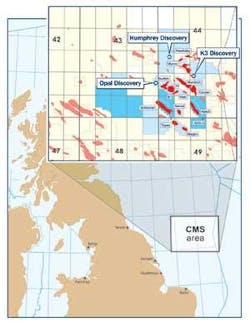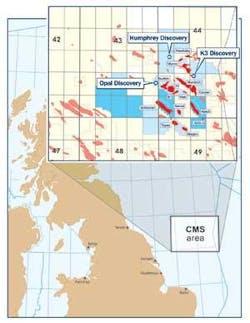OFFSHORE EUROPE
Jeremy Beckman, London
null
Norway setting pace for frontier exploration
Licensing activity is in full swing, with four countries announcing awards or inviting bids for offshore acreage.
Thirteen new production licenses have been issued under Norway’s 19th round, which focused mainly on under-explored sectors in the Barents Sea and Mid-Norway. Easily the most successful foreign applicant was BG Group, one of Norway’s more active newcomers in recent years. It gained five operatorships, while Norske Shell will control a four-block parcel in deep water in the Voering Basin.
Statoil gained two new licenses as operator in the eastern part of the Barents Sea, its first major award in this region for nine years. It has already secured a rig to drill a first well in 2007. Both of Hydro’s new operatorships were also in this sector.
In the Danish North Sea, Hydro will partner with Wintershall in three new shallow water licenses granted under Denmark’s 6th concession. One of these lies close to ConocoPhillips’ recent oil discovery Hejre; a development plan could be issued next year, according to Hydro.
Farther northwest, the Department of Trade and Industry has put 1,411 blocks and part-blocks out to tender under the UK’s 24th offshore licensing round, with bids due in by mid-June. Finally, Ireland’s government has taken applications for acreage in the Slyne-Erris-Donegal round. Among the applicants, Island Oil & Gas bid for blocks in the Southern Slyne and Donegal Basins where potential Triassic structures have been mapped.
No life yet on Uranus
Statoil’s latest exploration effort in the Barents Sea has yielded little, beyond data for a future campaign in the geologically complex North Cape Basin. The harsh environment semiEirik Raude drilled the Uranus prospect in production license 202, the main aim being to locate the same reservoir rock present in the small Pandora oil and gas find, 25-km distant. Statoil plans to re-evaluate its subsurface models, remaining convinced that Uranus and other structures in the vicinity are prospective.
In the North Sea, the company had better luck with an appraisal well on the high-pressure, high-temperature Gudrun structure in PL 025. Well 15/3-8, drilled by theTransocean Leader in 109 m of water, found oil and gas in late Jurassic sands, before terminating at 4,570 m TD. Two subsequent production tests flowed at 6-7,000 boe/d, through a 3/4-in. nozzle opening.
Gudrun was discovered by Elf in the 1970s and has been appraised since with numerous wells. Statoil says the results confirm its estimates of 150 MMboe recoverable, making the field commercial either through a new platform or a subsea solution. The nearest tieback possibilities appear to be Sleipner, 40 km to the south, or Marathon’s Brae complex, 13 km west of the Norway/UK median line. Marathon is also a partner in the Gudrun license.
Gas theory gains momentum
A new exploration fairway may be emerging in the southern UK gas basin. This follows three successive gas discoveries in North Sea quadrant 44 close to the Caister-Murdoch production complex, operated by ConocoPhillips.
According to Exploration Director Adrian Nel of partner Tullow Oil, the company views this little-explored region, abandoned years ago by most of the majors, as “Sherlock Holmes country”. Teams of geoscientists have been sifting through the available data in London. The resultant target horizons served up the recent Opal, Kelvin (K3), and Humphrey finds. K3 intersected good quality gas-bearing sands in a Lower Ketch interval, and development planning is already under way.
The partners are now lining up a well on the K4 prospect, just south of Kelvin, and Tullow is also part of a group taking a fresh look at Cygnus, an old gas discovery in a different play northeast of Humphrey. “We think we can make that well flow at commercial rates,” Nel says. On that basis, he adds, the partners would implement a novel completion technique; more significantly, a strong result might open-up a whole new section of Lower Leman sands north of Cygnus.
Farther south in the same quadrant, Tullow is revitalizing its operated Schooner and Ketch fields - originally developed by Shell and ExxonMobil - via a program of new wells and workovers. And in the Hewett complex of fields offshore Norfolk, which Tullow also operates, output was lifted recently through a new sidetrack on the Delilah field.
Busy pipelay season ahead on Ormen Lange
Late in March, Acergy’s laybargeLB200 resumed work on the northern section of Langeled, the world’s longest offshore pipeline network, which will take gas from the Ormen Lange field in the Norwegian Sea to Easington on England’s east coast.
TheLB200 picked up the 33-km section of line laid last year from Nyhamna, western Norway, by Allseas’ Solitaire. Laying will continue in a southwesterly direction to Statoil’s Sleipner complex in the North Sea. In August, the Solitaire will begin work in the opposite direction, from Sleipner, finishing its section of the pipeline in November. The two ends of this 362-km, 42-in. stretch of the northern line will be welded together next year.
This summer, theSolitaire will also install production pipelines toward the Ormen Lange field, to a location halfway down a potentially treacherous seabed feature known as the Storegga slide. At this point, 100 km offshore Nyhamna, Saipem’s S7000 will take over, laying the final 20 km over a particularly steep section of the slide and up to the templates, in a water depth of 850 m. This operation will entail J-lay of two sets of four pipelines welded together.
Acergy’sSeaway Falcon will install the projects’ antifreeze pipes this spring, with Subsea 7’s the Skandi Neptune laying one of the two control cables. The 120-km long consignment will be reeled out from one coil onboard the vessel.
The 540-km, 44-in. southern section of Langeled, from Sleipner to Easington, is being laid by theLB200.

